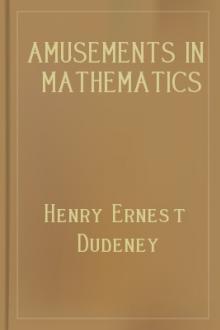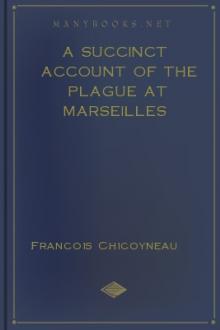Amusements in Mathematics, Henry Ernest Dudeney [books to read to be successful txt] 📗

- Author: Henry Ernest Dudeney
- Performer: 0486204731
Book online «Amusements in Mathematics, Henry Ernest Dudeney [books to read to be successful txt] 📗». Author Henry Ernest Dudeney
And each man has received his four pints of ale.
363.—THE DOCTOR'S QUERY.—solution
The mixture of spirits of wine and water is in the proportion of 40 to 1, just as in the other bottle it was in the proportion of 1 to 40.
364.—THE BARREL PUZZLE.—solution

All that is necessary is to tilt the barrel as in Fig. 1, and if the edge of the surface of the water exactly touches the lip a at the same time that it touches the edge of the bottom b, it will be just half full. To be more exact, if the bottom is an inch or so from the ground, then we can allow for that, and the thickness of the bottom, at the top. If when the surface of the water reached the lip a it had risen to the point c in Fig. 2, then it would be more than half full. If, as in Fig. 3, some portion of the bottom were visible and the level of the water fell to the point d, then it would be less than half full.
This method applies to all symmetrically constructed vessels.
365.—NEW MEASURING PUZZLE.—solution
The following solution in eleven manipulations shows the contents of every vessel at the start and after every manipulation:—
366.—THE HONEST DAIRYMAN.—solution
Whatever the respective quantities of milk and water, the relative proportion sent to London would always be three parts of water to one of milk. But there are one or two points to be observed. There must originally be more water than milk, or there will be no water in A to double in the second transaction. And the water must not be more than three times the quantity of milk, or there will not be enough liquid in B to effect the second transaction. The third transaction has no effect on A, as the relative proportions in it must be the same as after the second transaction. It was introduced to prevent a quibble if the quantity of milk and water were originally the same; for though double "nothing" would be "nothing," yet the third transaction in such a case could not take place.
367.—WINE AND WATER.—solution
The wine in small glass was one-sixth of the total liquid, and the wine in large glass two-ninths of total. Add these together, and we find that the wine was seven-eighteenths of total fluid, and therefore the water eleven-eighteenths.
368.—THE KEG OF WINE.—solution
The capacity of the jug must have been a little less than three gallons. To be more exact, it was 2.93 gallons.
369.—MIXING THE TEA.—solution
There are three ways of mixing the teas. Taking them in the order of quality, 2s. 6d., 2s. 3d., 1s. 9p., mix 16 lbs., 1 lb., 3 lbs.; or 14 lbs., 4 lbs., 2 lbs.; or 12 lbs., 7 lbs., 1 lb. In every case the twenty pounds mixture should be worth 2s. 4½d. per pound; but the last case requires the smallest quantity of the best tea, therefore it is the correct answer.
370.—A PACKING PUZZLE.—solution
On the side of the box, 14 by 224/5, we can arrange 13 rows containing alternately 7 and 6 balls, or 85 in all. Above this we can place another layer consisting of 12 rows of 7 and 6 alternately, or a total of 78. In the length of 249/10 inches 15 such layers may be packed, the alternate layers containing 85 and 78 balls. Thus 8 times 85 added to 7 times 78 gives us 1,226 for the full contents of the box.
371.—GOLD PACKING IN RUSSIA.—solution
The box should be 100 inches by 100 inches by 11 inches deep, internal dimensions. We can lay flat at the bottom a row of eight slabs, lengthways, end to end, which will just fill one side, and nine of these rows will dispose of seventy-two slabs (all on the bottom), with a space left over on the bottom measuring 100 inches by 1 inch by 1 inch. Now make eleven depths of such seventy-two slabs, and we have packed 792, and have a space 100 inches by 1 inch by 11 inches deep. In this we may exactly pack the remaining eight slabs on edge, end to end.
372.—THE BARRELS OF HONEY.—solution
The only way in which the barrels could be equally divided among the three brothers, so that each should receive his 3½ barrels of honey and his 7 barrels, is as follows:—
There is one other way in which the division could be made, were it not for the objection that all the brothers made to taking more than four barrels of the same description. Except for this difficulty, they might have given B his quantity in exactly the same way as A above, and then have left C one full barrel, five half-full barrels, and one empty barrel. It will thus be seen that in any case two brothers would have to receive their allowance in the same way.
373.—CROSSING THE STREAM.—solution
First, the two sons cross, and one returns Then the man crosses and the other son returns. Then both sons cross and one returns. Then the lady crosses and the other son returns Then the two sons cross and one of them returns for the dog. Eleven crossings in all.
It would appear that no general rule can be given for solving these river-crossing puzzles. A formula can be found for a particular case (say on No. 375 or 376) that would apply to any number of individuals under the restricted conditions; but it is not of much use, for some little added stipulation will entirely upset it. As in the case of the measuring puzzles, we generally have to rely on individual ingenuity.
374.—CROSSING THE RIVER AXE.—solution
Here is the solution:—
G, J, and T stand for Giles, Jasper, and Timothy; and 8, 5, 3, for £800, £500, and £300 respectively. The two side columns represent the left bank and the right bank, and the middle column the river. Thirteen crossings are necessary, and each line shows the position when the boat is in mid-stream during a crossing, the point of the bracket indicating the direction.
It will be found that not only is no person left alone on the land or in the boat with more than his share of the spoil, but that also no two persons are left with more than their joint shares, though this last point was not insisted upon in the conditions.
375.—FIVE JEALOUS HUSBANDS.—solution
It is obvious that there must be an odd number of crossings, and that if the five husbands had not been jealous of one another the party might have all got over in nine crossings. But no wife was to be in the company of a man or men unless her husband was present. This entails two more crossings, eleven in all.
The following shows how it might have been done. The capital letters stand for the husbands, and the small letters for their respective wives. The position of affairs is shown at the start, and after each crossing between the left bank and the right, and the boat is represented by the asterisk. So you can see at a glance that a, b, and c went over at the first crossing, that b and c returned at the second crossing, and so on.
There is a little subtlety concealed in the words "show the quickest way."
Everybody correctly assumes that, as we are told nothing of the rowing capabilities of the party, we must take it that they all row equally well. But it is obvious that two such persons should row more quickly than one.
Therefore in the second and third crossings two of the ladies should take back the boat to fetch d, not one of them only. This does not affect the number of landings, so no time is lost on that account. A similar opportunity occurs in crossings 10 and 11, where the party again had the option of sending over two ladies or one only.
To those who think they have solved the puzzle in nine crossings I would say that in every case they will find that they are wrong. No such jealous husband would, in the circumstances, send his wife over to the other bank to a man or men, even if she assured him that she was coming back next time in the boat. If readers will have this fact in mind, they will at once discover their errors.
376.—THE FOUR ELOPEMENTS.—solution
If there had been only three couples, the island might have been dispensed with, but with four or more couples it is absolutely necessary in order to cross under the conditions laid down. It can be done in seventeen passages from land to land (though French mathematicians have declared in their books that in such circumstances twenty-four are needed), and it cannot be done in fewer. I will give one way. A, B, C, and D are the young men, and a, b, c, and d are the girls to whom they are respectively engaged. The three columns show the positions of the different individuals on the lawn, the island, and the opposite shore before starting and after each passage, while the asterisk indicates the position of the boat on every occasion.





Comments (0)